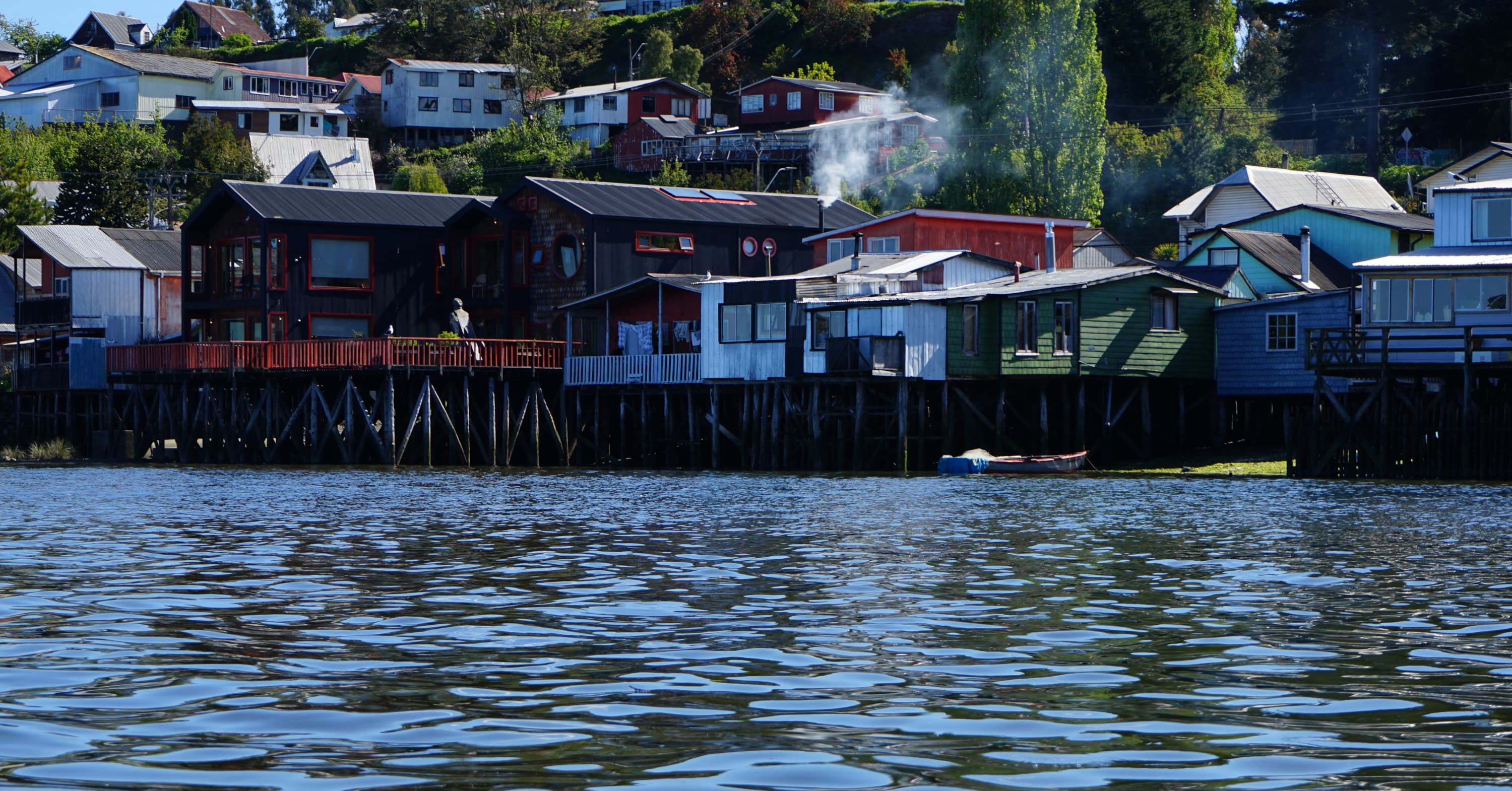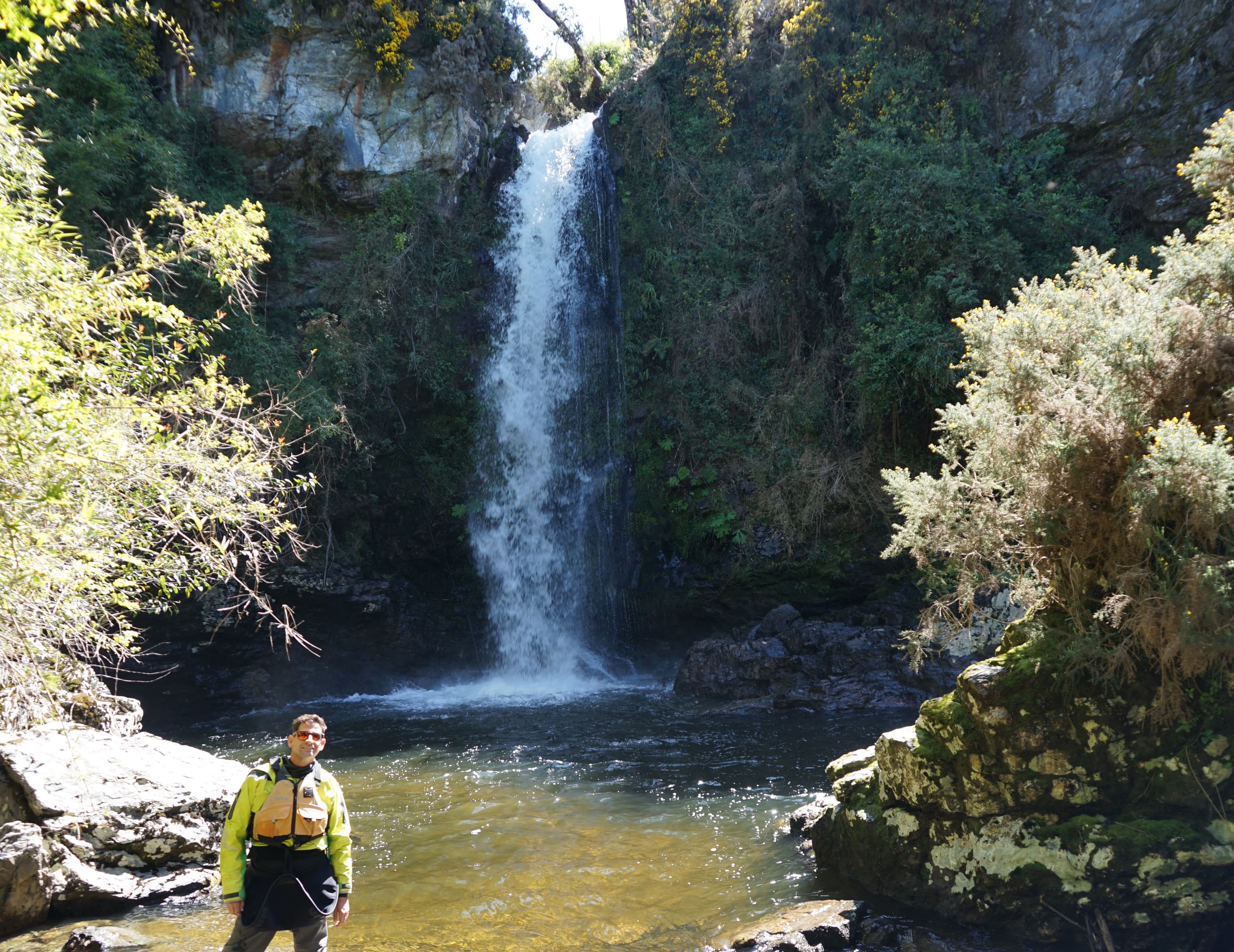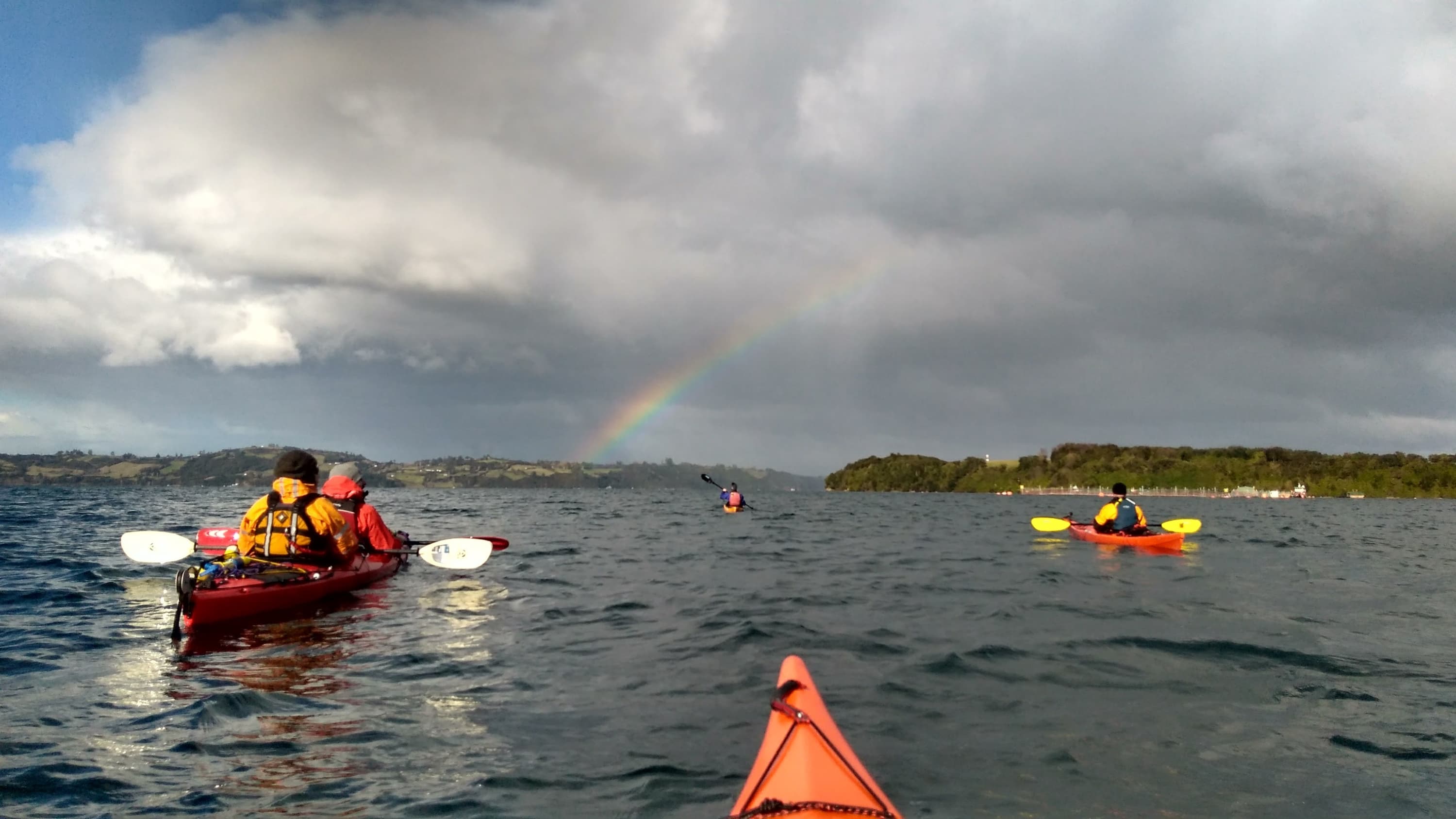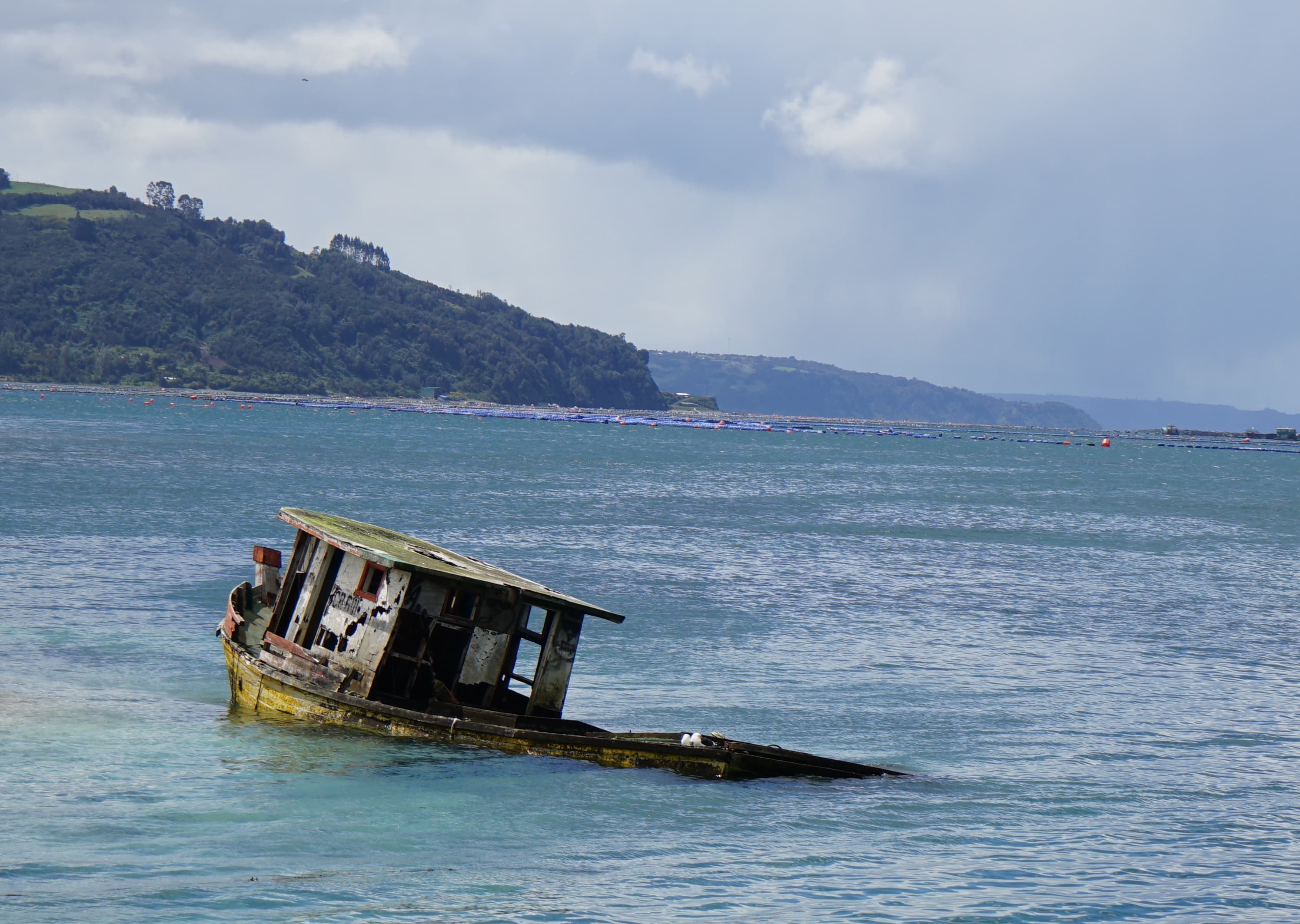Chiloé: Uncovering This Chilean Archipelago’s Secrets by Kayak

With UNESCO World Heritage sites, unique and stunning harbor towns, some of the most incredible fresh seafood in the world, and top-notch paddling, it’s a wonder why more paddling lovers haven’t visited Chiloé. Located on the southern edge of the enchanting, lush, and adventurous Lagos region, Chiloé and its surrounding 40 islands that make up this archipelago have endless small harbor town charm and are one of Chile’s most incredible travel destinations. While not a household name like Easter Island, Tierra Del Fuego, or even Torres Del Paine, Chiloé Island, Chile’s second-largest island, is a place that every paddling enthusiast should add to the top of their travel list.
What makes Chiloé such an incredible paddling destination is its diverse appeal. It has various ecosystems you can paddle in and out of, from fjords to waterfalls to freshwater rivers in a single paddle. It is also rich in its biodiversity, with nearly 150 bird species, as well as exotic marine life. The various quaint harbor towns offer great respite after a long paddle, with their cultural points of interest and world-class seafood.
The decision to visit Chiloé Island is an easy one for any adventurous paddler. Charles Darwin even visited Chiloé during his famous expedition on the Beagle. But while visiting is a no-brainer, planning the perfect paddling trip to this Chilean archipelago, and even just arriving here can be a bit more challenging. To ensure you experience the magic Chiloé has to offer, you need to know what makes this island so special, when you should visit, and where to stay.

Six Reasons To Visit Chiloé Island On A Paddling Vacation
I recently made the trip to Chiloé Island and was immediately struck by how it at once felt otherworldly, and oddly familiar. It has quiet rolling green hills with healthy wandering sheep that could just as easily be located in the Scottish Highlands. Its harbor towns have a small-town Maine or Nova Scotia feel. But as you notice the details of the islands, like men selling seaweed on street corners, and salmon ceviche being made-to-order on the docks, you quickly see this place is truly one of a kind.
After exploring the island for more than a week and paddling its waters for many hours, I have uncovered some of the true standout attributes of this island from a traveling paddler’s perspective.
1. Diverse Paddling Landscapes
The best paddling experience while visiting Chiloé was a guided kayaking excursion through the Fjord of Castro. The tour was with Chiloé Natural, and this half-day tour was loaded with adventure. After paddling just over 11 kilometers, I kayaked through a fjord with migrating birds flying just above my head, explored multiple waterfalls and freshwater rivers, and paddled up close to Castro’s famous Palafito stilt houses - and so much more. A calm paddling trip rarely feels like such an epic adventure.
I spoke with Cyril Christensen, the Director of Chiloé Natural about kayaking in Castro, and what makes this area so special.
“Exploring the Fjord of Castro by kayak provides a unique perspective on the Palafitos (houses on stilts) offering a unique angle to appreciate Chiloé's culture and its deep connection with water,” he said. But it isn’t only the landscapes that make Chiloé ideal for paddling.
2. Unique Marine Life Spotting Opportunities
Chiloé has both a protected bay and the wild Pacific Ocean, which makes it a popular place for exotic wildlife viewing, specifically marine life. According to Christensen, there are all sorts of marine animals you can see while kayaking, including “four kinds of dolphins, sea lions, river and sea otters, and, during certain seasons, whales like orcas and humpbacks if lucky.” Keep in mind these animals often migrate, they are only visible at certain times of the year.
3. Heaven For Bird Lovers
Chiloé is also a hotspot for bird activity. While Chile as a whole has more than 430 types of birds, nearly 140 of these species fly through, or permanently reside in the Chiloé archipelago. On my weeklong trip I saw multiple migrating bird species, and several colorful birds I could not identify, but am certain I had never seen before. Kayaking is a great way to see many of these birds, as they tend to hang out and nest along the shore, and frequently fly over the tranquil waters.
4. Well-Protected Waters
Much of Chile’s saltwater paddling can be risky or highly weather-dependent. The waters are often cold and unforgiving, and the further south you go, the windier it gets. One amazing thing about Chiloé is its many protected waters make it easy to find a safe place to paddle on most days.
5. Warmer Conditions Than Southern Patagonia
While the weather is sometimes depressingly wet, it is important to note that Chiloé has warmer, and far more idyllic paddling weather in the summer than southern Patagonia where the temperatures stay in the 50s and low 60s in the summer. Chiloé has slightly warmer weather, with no glaciers or icebergs floating while you paddle that give off that frigid Patagonia wind the south experiences throughout the year.
6. Chiloé Is Family Friendly
Much of Patagonia is safe and easy to do at your own pace, but this is particularly true of Chiloé. Much of the archipelago can be seen by using a car, rather than having to trek for miles to see the best lookouts. It also offers family-friendly paddling on good weather days thanks to the protected waters. According to Christensen, “We have experienced quite a few father-son and mother-daughter moments on double kayaks sharing the experience in the fjord of Castro as well as kayaking in Huillinco and Cucao near the National Park.”

When To Plan Your Paddling Trip To Chiloé
Chiloé is always beautiful, but weather can have a profound impact on what you can and can’t - or at least shouldn’t - do on a trip to this region. If possible, it is best to visit Chiloé between November and late March, with December through early March being the peak times to visit Chiloé for all outdoor activities.
The weather this time of the year is warmer, but more importantly, it is also much sunnier. Chiloé is a stunning and lush green, and this is because it rains a lot here. It is wet throughout the winter. So while you may find off-season prices, it is best to wait until at least the start of November and even December to book your trip.
In addition to warmer and sunnier days, December through February also experience very long days. This allows you lots of daylight for paddling, as well as squeezing in at least one additional sightseeing activity each day.
It is important to remember that the time of the year also impacts the type of wildlife you can see in Chiloé. According to Christensen from Chiloé Natural, “During the warmer months, you may encounter migratory bird species, and the chance of spotting whales increases. Spring and early summer also bring lush vegetation and blooming flowers. In winter we get flamingos.” So while you can’t see everything throughout the year, each season offers something special.

Top Tips To Know Before Visiting Chiloé Island For Paddling
Pick A Central Location For Your Accommodation
There are many stunning and picturesque towns in Chiloé, but it pays to have a central location. Castro is a popular place to stay when visiting Chiloé. It is the main hub for buses, and it has the most stores, which makes it easy to stock up on groceries and supplies. It also has some of its charming attributes, including the famous houses on stilts, known as palafitos.
For a slightly less crowded feel, consider Dalcahue, a smaller harbor town with great food, a craft market, and just a 30-minute drive from Castro. If you want to be off the beaten path, consider one of Chiloé’s smaller islands, like the stunning Isla Lemuy.
Activities Vary Based On Time Of Year
Remember that winter starts in June and the summer in December, and activities vary significantly based on the time of year. As a paddler, it is best to plan a trip between November and March. This gives you the best chance to experience pleasant paddling and exploring weather.
Plan At Least One Guided Tour
One of the benefits of Chiloé not being a wildly popular International destination (at least not as much as places like Torres Del Paine) is that parts of it are still unknown to many tourist guides and blogs. This uncharted territory is part of the area’s appeal, but this also means it is best to explore Chiloé with a kayaking guide.
There are several rivers, animals, and waterfalls I never would have seen (all of which were major highlights), if not for my guided tour with Chiloé Natural. Kayaking on a guided tour might cost more than a rental, but you will likely have a profoundly more fulfilling experience.
Bring Clothes For Various Weather Conditions
Like anywhere in Patagonia and coastal Chile, weather in Chiloé can change dramatically throughout the day. Make sure you pack for warm sunny days, and cold, windy, and rainy days as well. You are likely to experience both, often on the same day. Layers and a waterproof shell are a must.
Keep Your Plans Flexible
Planning is great, and it is always a good idea to research all the places you want to see while visiting Chiloé - both paddling spots and other top tourist sites. But make sure you have some flexibility. Weather can dictate your plans here more than many other paddling destinations. When there is a chance of sun and little wind, it’s time to paddle. Rainy days, on the other hand, make for great church viewing and dining-out excursions.
Bring Your Appetite
The food in Chiloé is unique and incredible. Chile is not particularly cheap, especially when it comes to food, but thanks to the abundance of seafood in this Archipelago, you can get some of the best seafood of your life for shockingly low prices. Curanto is a signature steamed seafood and meat dish that combines shellfish, chicken, dumplings, and even a ham hock, and must be tried after a long paddle. Salm ceviche is everywhere and usually costs around $3 for a generous portion.
Consider Renting A Car
Chiloé Island is Chile’s second-largest island, and driving end-to-end can take hours. Many buses reach the more populated towns, and even Chiloé National Park regularly. Tour companies often offer pick-up service as well, but it is nice to have a car for a day or two. Exploring Chiloé by car allows you the freedom to explore its most rural and untouched areas, see all of its renowned churches, and even find some lesser-known paddling spots. Don’t worry, if you are on a budget, you can make it work with only buses, just make sure to pack your patience.

Final Notes On Why Visiting Chiloé Is Perfect For Kayakers
Chiloe is a well-preserved gem that has both wild Patagonian elements like the areas to its south, as well as tranquil waters of the relaxing and stunning Lagos region to the north. It has some of the best wildlife viewing a paddler could hope for. There are about 140 types of bird species you can spot throughout the year, as well as multiple dolphin and whale species that pop up from time to time in their well-protected and bountiful waters.
Visiting Chiloe for kayaking and other types of paddling is a trip best taken between November and March, when the days are long, and there is a much higher chance of sunshine. Many people like to combine a trip to Chiloe with a longer Patagonia trip or as the final stop on a trip in the Lagos Region. Both are great ideas, but this 40-island archipelago also stands alone as a worthy and truly unique international paddling destination.
Some photos in this story were provided by Chiloé Natural.
Related Articles
SUP boards are fantastic vessels for those looking to exercise while taking a quick loop in friendly…
A short film produced (and paddled) by Jeremy T. Grant of the Timber Cross Film and Media. For more…
Learn how to do a one person lift and a one person carry on a portage. No matter how "strong" you…
Who needs water when you have ice or a paddle when you have a friend?



